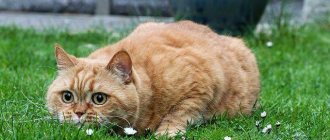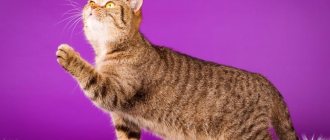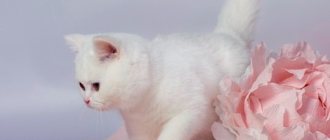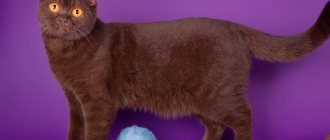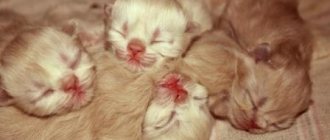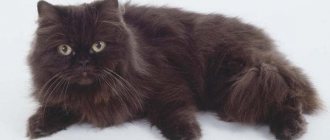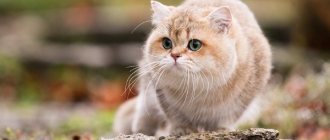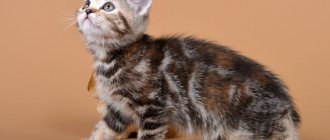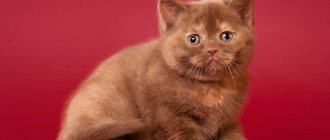The tortoiseshell color of British cats is also called tortie. This is a unique color of its kind. Tri-colored British tortoiseshells combine two groups of colors at once: black (and lightened blue, lilac, chocolate, cinnamon and fawn) and red (and lightened cream).
That is, in simple words, when dark colors meet red or cream, they get turtles.
TYPES OF BRITISH TORTIETY COLORS
There are more than 80 variations of bright colors in tortoiseshell cats, and each cat is unique. And there is not a single turtle in the world that would replicate every spot and every hair of its fur identically.
Let's divide all types of colors into subgroups.
CLASSIC TURTLES
| Blue cream (BRI g) | Black-red (BRI f) | Chocolate red (BRI h) |
| Lilac-cream (BRI j) | Fawn cream (BRI r) | Cinnamon red (BRI q) |
SMOKY TURTLES
Smoke tortoiseshells are a color that combines the classic tortoiseshell with smoke (silver colored at the roots). Such turtles are rare and outwardly almost do not differ from classic ones, since the undercoat, which is visible only if you part the fur, can be immediately overlooked. Looking at such a cat, one gets the impression that the color is not entirely bright, but rather slightly blurred. This feature appears due to smoke in the undercoat. The color looks smoother, areas of differently colored parts are smoothed out.
Smoky colors are:
- black-red smoky BRI fs;
- chocolate red smoky BRI hs;
- blue-cream smoky BRI gs;
- lilac-cream smoky BRI js;
- cinnamon-red smoky BRI qs;
- faun cream smoky BRI rs.
3. TORBIE (TORTOISE TABBY)
This type of color - torby - is represented by a combination of the classic tortoiseshell color and tabby color (pattern).
TORBY is BLACK (or other lightened tone) + RED (or cream) + TABBY (pattern).
Types of colors:
- black and red tabby (spot, stripe, marble) f 24, f 23, f 22;
- chocolate-red tabby (spot, stripe, marble) h 24, h 23, h 22;
- blue-cream tabby (spot, stripe, marble) g 24, g 23, g 22;
- lilac-cream tabby (spot, stripe, marble) j 24, j 23, j 22;
- cinnamon-red tabby (spot, stripe, marble) q 24, q 23, q 22;
- fawn-cream tabby (spot, stripe, marble) r 24, r 23, r 22.
CAKE (TORTOISE COLOR POINT)
Tortie is the name of a color that combines tortoiseshell and color point (otherwise known as Siamese).
This rare combination of colors is obtained as a result of mixing different groups of colors and adding the color point gene (it must be present in both parents).
CAKE is BLACK (or other lightened tone) + RED (or cream) + POINT (Siamese).
Colors can be:
- torty point (black tortoiseshell) f 33;
- blue cream point (blue tortoiseshell) g 33;
- chocolate-tortie-point (chocolate tortoiseshell) h 33;
- lilac-torty-point (lilac tortoiseshell) j 33;
- cinnamon-tortie-point (tortoiseshell cinnamon) q 33;
- fawn-torty-point (tortoiseshell fawn) r 33.
CALICO (BICOLOR TURTLES)
The calico color is also called the “patchwork tortoiseshell.” This is one of the most beautiful and elegant colors - tortoiseshell combined with white (you can also hear the name tricolor). It is put together like a mosaic from “scraps” of different colors. These turtles are three-colored, and different colors do not mix or shade, but have clear contours.
CALICO is BLACK (or other lightened tone) + RED (or cream) + WHITE.
Tortoiseshell Tricolor Britons can be:
- black tortoiseshell with white (f 03/02/01);
- blue tortoiseshell with white (g 03/02/01);
- chocolate tortoiseshell with white (h 03/02/01);
- lilac tortoiseshell with white (j 03/02/01);
- tortoiseshell cinnamon with white (q 02/03/01);
- tortoiseshell faun with white (r 03/02/01).
where 03 is bicolor, 02 is harlequin, 01 is van.
MIXED COLOR: TORTIE TABBY WITH WHITE
Tortoiseshell cats can also have a tabby pattern, combining 3 colors at the same time. Tortoiseshell tabbies with white colors are obtained by mixing several types of colors; they are rare.
TORTIE TABBY WITH WHITE is BLACK (or other lightened tone) + RED (or cream) + TABBY + WHITE.
There are a lot of color options. And, like all turtles, the color is always elegant, bright and unique.
What signs, beliefs and superstitions are associated with tricolor cats?
Can a calico cat in the house bring good luck to its owners? There are many signs and superstitions associated with tricolor cats, both in Russia and in Europe, America and Muslim countries. It is believed that a colorful pet has magical powers and brings wealth and success.
Almost all signs concerning “turtles” are related to money. It is believed that the house where such a cat lives will always be full, and the owners will have good luck in financial matters. For a long time, businessmen, bankers, and entrepreneurs have tried to keep such pets. They believed that an animal endowed with mystical powers could increase their wealth, protect them from scammers and thieves, and even ward off pirates!
The tricolor cat came into the house on its own - why is this? Just by appearing, a tortoiseshell cat brings good luck. If she accidentally strays towards the house, under no circumstances should she be driven away. A multi-colored cat will bring happiness, and unmarried girls should prepare to enter into a happy and profitable marriage.
Another sign is related to how exactly a cat should appear in a new home. Often, owners give newborn kittens away to their friends as gifts, just to get rid of them as quickly as possible. Legend has it that you must pay for a tricolor kitten so as not to get good luck for nothing. Money can be symbolic, even one penny is enough.
Three-haired cats are credited with not only helping with money matters. People say that they know how to relieve pain and treat their owners. The animal lies down on the sore spot and relieves the painful sensations with its quiet and monotonous rumbling. Scientists have proven that there is some truth in this sign; cats can actually lie down at the site of inflammation, because the temperature there is higher than in other parts of the body.
Of course, these are all folk signs and superstitions, and everyone decides for himself whether to believe in them or not. What can be said for sure is that a playful pet with an unusual color will definitely bring a lot of joy to its owners.
TORTIE BRITISH: COLOR STANDARD
British tortoiseshell tricolors combine finely spotted colors in equally distributed tones of the red and black color groups or patchwork (in the case of a combination with white).
The color should look harmonious. The tones of the two color groups must be distributed evenly throughout the body; spots of the red group are allowed.
The fur of British tortoises is soft, dense, plush, exceptionally short and slightly protruding (not lying close to the body).
The eyes of a British tortoiseshell cat can be either copper or dark gold.
The nose and paw pads can be:
- black;
- pink;
- black and pink.
See the tortoiseshell color of the British cat in the photo in this article.
Care
Blue Britons require care in several ways.
- It happens that discharge occurs around the eyes, and this occurs in both kittens and adults. For cleaning, use a cotton swab previously soaked in an eye wash solution. If the discharge is purulent in nature, then your pet should definitely be shown to a veterinarian.
- Ears also require care. In normal condition, they should be clean, odorless and uniform in color. To clean your ears, you need to take a cotton swab dipped in a special solution.
- To comb the fur, special brushes are used, which are equipped with either rubber or metal bristles, which should not injure the pet’s skin. Brushing should be taught from a young age so that kittens already understand what is being done to them. The pet must be patient with this care. It is necessary to be especially careful when brushing during the molting period. This procedure will help prevent hair from appearing on furniture, carpets and other places. To collect the hair after the procedure, you can use a special rubber glove or a damp hand. Bathing is not included in the set of mandatory actions.
Blue British cats have excellent immunity. If you care for them properly, they are practically not prone to diseases. If there is the slightest change in your pet’s behavior, you should contact a veterinarian for help, then you can help the animal and avoid serious complications.
To learn about the intricacies of keeping blue British cats, see the following video.
IS THERE A TORTIE BRITISH CAT?
Here the matter is in the usual genetics of the colors of the British.
There is no tortoiseshell color in British cats - only in cats. If this could happen, then the cat would be sterile, i.e. could not have offspring.
The fact is that cats have two X chromosomes, each of which can carry either black color (or its derivative) or red (or cream). The combination of X chromosomes from two different color groups in a cat gives the tortoiseshell color. But cats have only one X chromosome, so they can only be black or only red.
Cat breed codes
Three large capital letters indicate the cat's breed code.
| PER | Persian | Persian |
| ACL | American Curl longhair | American Curl DS |
| AVT | American bobtail | American Bobtail |
| BAL | Balinese (Balinesian) | Balinese (Balinese) |
| BLH | British longhair | British Longhair |
| C.Y.M. | Cymric | Cymric |
| HHP | Household Pet | Domestic cat |
| JAV | Javanese | Javanese (Oriental DS) |
| JBL | Japanese Bobtail longhair | Japanese bobtail longhair, |
| KAV | Karelian bobtail longhair | Karelian Bobtail |
| KVL | Kurilian bobtail longhair | Kurilian Bobtail |
| LPL | La Perm longhair | La Perm longhair |
| MCO | Maine coon | Maine Coon |
| MNL | Munchkin longhair | Munchkin longhair |
| NEB | Nebelung | Nibelung |
| NEV | Neva maskarade | Neva Masquerade |
| NFO | Norwegian Forest Cat | Norwegian forest |
| O.S.L. | Oriental Semilonghair | Oriental Semi-Longhair (Mandarin) |
| RAG | Ragdoll | Ragdoll |
| R.G.M. | Ragamuffin | Ragamuffin |
| SBI | Sacred Birman | Burmese (Sacred Burma) |
| SFL | Highland Fold | Scottish fold DS (Highland fold) |
| SIB | Siberian | Siberian |
| SOM | Somalia | Somali (Somali) |
| SRX | Selkirk Rex longhair | Selkirk Rex DSH |
| SYL | Seychellois longhair | Seychelles DS |
| TIF | Tiffani (Tiffanie) | Tiffany (Asian DS, Mahogany, Chantilly) |
| TUA | Turkish angora | Turkish Angora |
| TUV | Turkish van | Turkish van |
| URL | Ural Rex longhair | Ural Rex longhair |
| URX | Ural rex longhair | Ural Rex DSh |
| YOR | York Chocolate | York (York) |
| ABY | Abyssinian | Abyssinian |
| ACS | American Curl shorthair | American Curl, Ameerika Curl luhikavaline, |
| A.N.A. | Anatolian | Anatolian (Turkish KS) |
| ARM | Arabia Mau | Arabian Mau |
| A.S.H. | American shorthair | American Shorthair |
| A.S.I. | Asian (tabby, smoke) | Asian (tabby, smoky) |
| AUM | Australian Mist | Australian Smoke (Mist) |
| AWH | American wirehair | American Wirehair |
| BEN | Bengalian (Bengal) | Bengal |
| BOM | Bombay | Bombay |
| BRA | Brazilian Shorthair | Brazilian Shorthair |
| BRI | British shorthair | British Shorthair |
| BMI | Burmilla | Burmilla |
| BUR | Burmese (Burma) | Burmezskaya (Burmese) |
| CEY | Ceylon | Ceylon |
| SNA | Chartreux | Chartreuse (Carthusian) |
| CRX | Cornish-rex | Cornish Rex |
| CSP | Califomian splendid | California radiant |
| DRX | Devon Rex | Devon rex |
| DSX | Don Sphinx | Don Sphynx |
| EUR | European shorthair (Celtic) | European CS (Celtic) |
| EXO | Exotic shorthair | Exotic Shorthair |
| GRX | German rex | Hermann rex (German rex) |
| HHP | Household Pet | Domestic cat |
| HVB | Havana brown | Havana brown |
| JAV | Javanese | Javanesian |
| J.B.T. | Japanese bobtail | Japanese Bobtail |
| KAN | Kanaania | Kanaani (Kanaanskaya) |
| KAS | Karelian Bobtail shorthair | Karelian Bobtail KSh |
| KBS | Kurilian Bobtail shorthair | Kurilian Bobtail KSh |
| KOR | Korat | Korat |
| MAN | Manx | Manx (Manx, Manx) |
| MAU | Egyptian mau | Egyptian Mau |
| MNS | Munchkin shorthair | Munchkin KSH |
| OCI | Ocicat | Ocicat |
| RUS | Russian blue | Russian blue |
| SFS | Scottish-fold (CN) | Scottish Fold (Scottish Fold) |
| SIN | Singapura | Singaporean (Singapore) |
| SNO | Snow-shoe | Snow-shoe |
| SOK | Sokoke | Sokoke |
| SPH | Sphinx (Canadian sphinx) | Canadian Sphynx |
| SRS | Selkirk Rex shorthair | Selkirk Rex shorthair |
| URX | Ural Rex shorthair | Ural Rex shorthair |
| MBT | Mekong Bobtail | Mekong Bobtail |
| PBD | Peterbald | Peterbald (Petersburg Sphinx) |
| OKH | Oriental shorthair | Oriental Shorthair |
| SYS | Seychellois shorthair (Siamese bicolour) | Seychelles KS |
| SIA | Siamese | Siamese |
| TBT | Thai bobtail | Thai Bobtail |
| THA | Thai | Thai |
| TON | Tonkinese | Tonkinese |
| NON | Unregistered race | Unregistered breed |
HOW IS THE TORTIE COLOR FORMED?
When a kitten develops color, it is formed by two chromosomes - one is taken from the mother, the other from the father.
Cat: XX (black+black, red+red, black+red)
Cat: XY (black+male, red+male)
| EXAMPLE 1. Mom is black, solid color. Dad is a red solid color. The female kitten (XX) takes on the black color from one X chromosome from the mother, and the red color from the second X chromosome from the father. It turns out to be a tortoiseshell kitten. Male kitten (XY) The X-chromosome from the mother takes the black color, the Y-chromosome from the father takes the male color. The result is a black male kitten. | |
| EXAMPLE 2. Mom is black, solid color. Dad is a black monochromatic color. A female kitten (XX) takes on the black color from one X chromosome from the mother, and takes on the black color from the second X chromosome from the father. It turns out to be a black kitten. Male kitten (XY) The X-chromosome from the mother takes the black color, the Y-chromosome from the father takes the male color. The result is a black male kitten. | |
| EXAMPLE 3. Mom is black tortoiseshell (a combination of black and red) color. Dad is a black monochromatic color. Girls (XX) can get either black or red color from their mother, and always black from their dad. Those. girl kittens can be:
Boys (XY) can also take either black or red color from their mother, and only male from their father. Those. male kittens can be:
| |
| EXAMPLE 4. Mom is black tortoiseshell (a combination of black and red) color. Dad is a red solid color. Girls (XX) can get either black or red color from their mother, and always red from their dad. Those. girl kittens can be:
Boys (XY) can also take either black or red color from their mother, and only male from their father. Those. male kittens can be:
|
BRITISH TORTIE KITTENS
British tortoiseshell kittens are born from parents of different color groups, for example, mom belongs to the black group and dad to the red group (or vice versa). Such British tortoiseshell kittens are just a treasure for breeders who take them for further work in the nursery. The fact is that babies from turtles come in such a wide range of colors that you cannot get from any other cat.
The surprising thing is that British tortoiseshell cats are unique - there are no repetitions or “samenesses”, each cat is elegantly colored in its own way and no two cats are alike.
For photos of tricolor British tortoiseshell kittens, see the sections divided by color type.
In our nursery you can buy a British tortoiseshell kitten. See the section “KITTENS FOR SALE”.
| In our cattery you can “buy a real British kitten.” We have many different colors, we will help you choose and answer all your questions! |
Care and maintenance
Before you get a Briton, it is important to purchase all the accessories necessary for him:
- Sleeping area. Representatives of this breed love to be alone, so it is recommended to buy them a bed or a house, which should be placed in a secluded and quiet place.
- A bowl. Metal utensils with high sides are suitable for food, and ceramic ones for water.
- Tray. Breeders advise using a plastic high box. It is recommended to choose the filler from wood material.
- Comb. It is better to comb a soft, plush fur coat with a massage brush.
- Cloth. The British have a hard time withstanding frost, so it is worth purchasing a warm wardrobe for winter walks.
- Scratching post. It will help wean furry ones from the habit of sharpening their claws on furniture.
If the animal gets used to being in human hands, it will be easier for the owner to care for it.
When you get a British tortoiseshell cat, first of all you should establish a chain of command between the owner and the pet. If the rules of behavior are followed well, it is recommended to reward your pet by treating him with a treat. If the cat misbehaves, you should immediately scold him without using force. Despite the fact that this breed is distinguished by its cleanliness, the kitten needs to be taught to handle hands in order to calmly care for its eyes, ears, and claws, where the tortoiseshell fold cat cannot reach on its own.
Caring for British cats is not difficult, but it is worth remembering and observing some nuances. The main advantage of the breed is its coat. The animal should be combed 1-2 times every 7 days. With a special brush you can remove any loose hair and massage your furry friend. In addition, it is necessary to trim the nails twice a month, even if there is a scratching post.
You should clean your eyes with a damp cotton swab every day to avoid accumulation of discharge.
The ears also need to be paid attention. Use a cotton swab dipped in boiled water to treat the ears.
You will need to examine your mouth every day. If tartar deposits are noticed, dry food should be introduced into the diet, which successfully copes with this problem.
An important aspect of caring for cats is nutrition. Many owners prefer to feed their pets industrial complementary foods. Such food contains all the necessary vitamins and microelements. The main thing is that the tortoiseshell cat, in addition to this food, receives a sufficient amount of liquid. If your pet eats only natural products, then the diet should include raw lean meat, boiled fish and chicken, cereals and vegetables. You should feed your pet 2-3 times a day.

